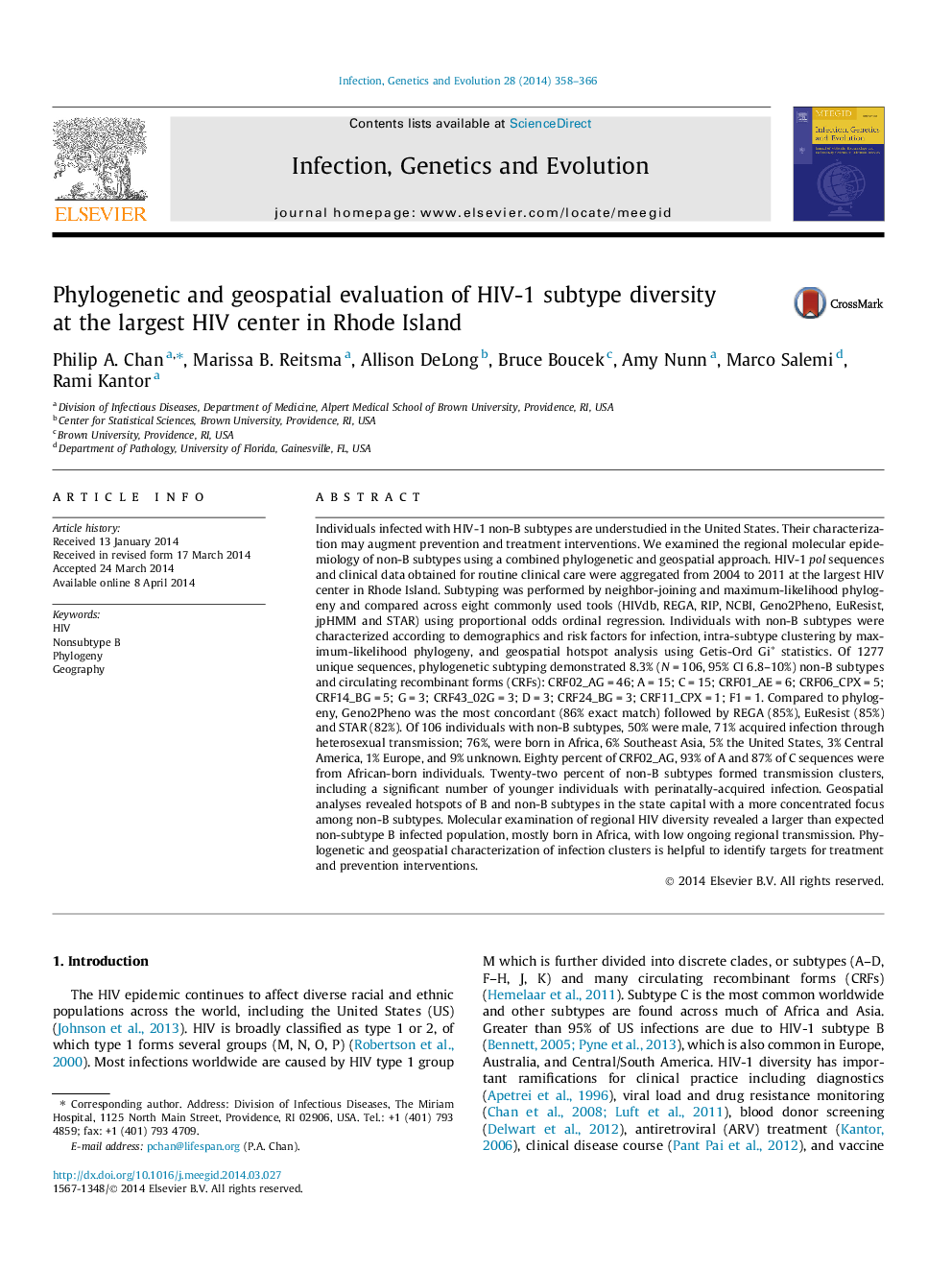| Article ID | Journal | Published Year | Pages | File Type |
|---|---|---|---|---|
| 5909489 | Infection, Genetics and Evolution | 2014 | 9 Pages |
â¢We evaluated HIV-1 non-B subtype epidemiology using a phylogenetic and geospatial approach.â¢Individuals with non-B subtypes had different risk factors for infection than those with subtype B.â¢Non-B subtypes formed fewer phylogenetic transmission clusters suggesting more imported cases.â¢Non-B subtypes formed geospatial clusters in select urban neighborhoods.â¢Epidemiology of non-B subtypes suggests specific areas for outreach, treatment, and prevention.
Individuals infected with HIV-1 non-B subtypes are understudied in the United States. Their characterization may augment prevention and treatment interventions. We examined the regional molecular epidemiology of non-B subtypes using a combined phylogenetic and geospatial approach. HIV-1 pol sequences and clinical data obtained for routine clinical care were aggregated from 2004 to 2011 at the largest HIV center in Rhode Island. Subtyping was performed by neighbor-joining and maximum-likelihood phylogeny and compared across eight commonly used tools (HIVdb, REGA, RIP, NCBI, Geno2Pheno, EuResist, jpHMM and STAR) using proportional odds ordinal regression. Individuals with non-B subtypes were characterized according to demographics and risk factors for infection, intra-subtype clustering by maximum-likelihood phylogeny, and geospatial hotspot analysis using Getis-Ord Giâ statistics. Of 1277 unique sequences, phylogenetic subtyping demonstrated 8.3% (NÂ =Â 106, 95% CI 6.8-10%) non-B subtypes and circulating recombinant forms (CRFs): CRF02_AGÂ =Â 46; AÂ =Â 15; CÂ =Â 15; CRF01_AEÂ =Â 6; CRF06_CPXÂ =Â 5; CRF14_BGÂ =Â 5; GÂ =Â 3; CRF43_02GÂ =Â 3; DÂ =Â 3; CRF24_BGÂ =Â 3; CRF11_CPXÂ =Â 1; F1Â =Â 1. Compared to phylogeny, Geno2Pheno was the most concordant (86% exact match) followed by REGA (85%), EuResist (85%) and STAR (82%). Of 106 individuals with non-B subtypes, 50% were male, 71% acquired infection through heterosexual transmission; 76%, were born in Africa, 6% Southeast Asia, 5% the United States, 3% Central America, 1% Europe, and 9% unknown. Eighty percent of CRF02_AG, 93% of A and 87% of C sequences were from African-born individuals. Twenty-two percent of non-B subtypes formed transmission clusters, including a significant number of younger individuals with perinatally-acquired infection. Geospatial analyses revealed hotspots of B and non-B subtypes in the state capital with a more concentrated focus among non-B subtypes. Molecular examination of regional HIV diversity revealed a larger than expected non-subtype B infected population, mostly born in Africa, with low ongoing regional transmission. Phylogenetic and geospatial characterization of infection clusters is helpful to identify targets for treatment and prevention interventions.
